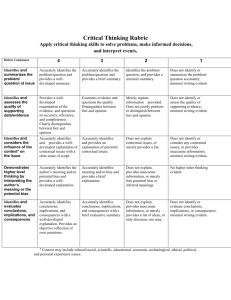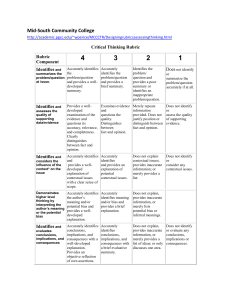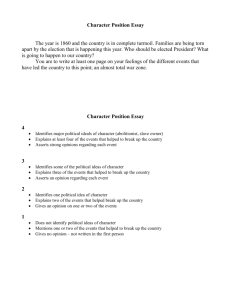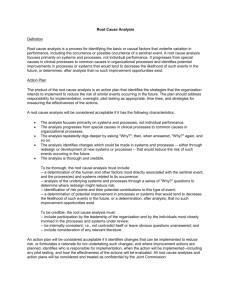Teaching Critical Thinking Browning General Education Core Skill Area Workshop
advertisement
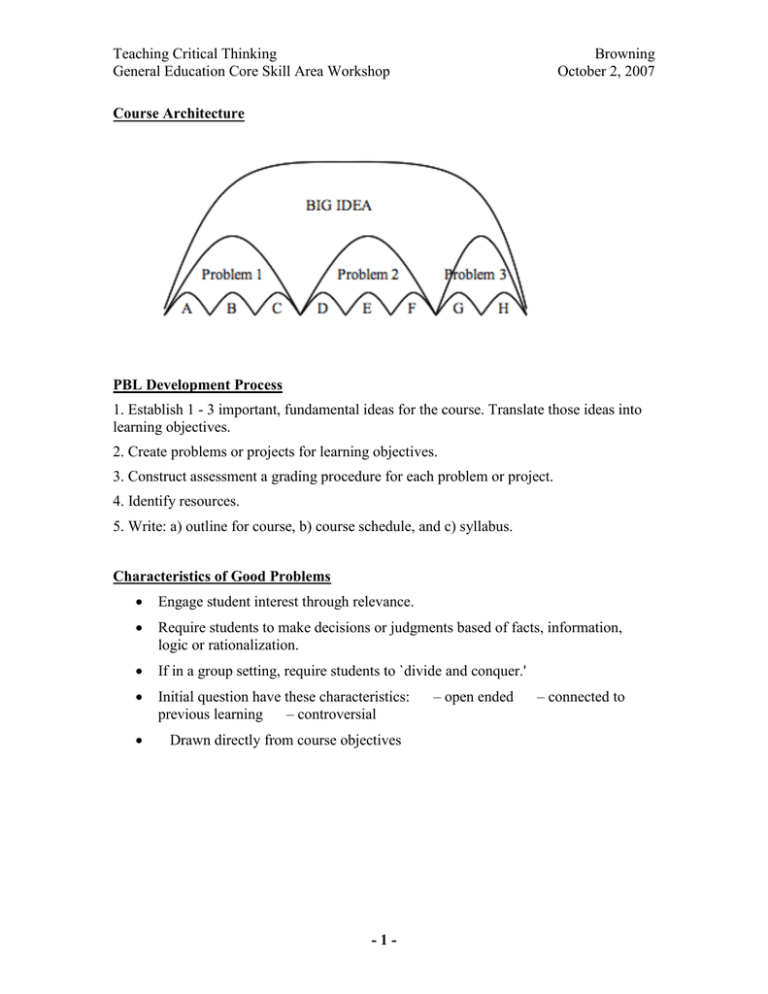
Teaching Critical Thinking General Education Core Skill Area Workshop Browning October 2, 2007 Course Architecture PBL Development Process 1. Establish 1 - 3 important, fundamental ideas for the course. Translate those ideas into learning objectives. 2. Create problems or projects for learning objectives. 3. Construct assessment a grading procedure for each problem or project. 4. Identify resources. 5. Write: a) outline for course, b) course schedule, and c) syllabus. Characteristics of Good Problems Engage student interest through relevance. Require students to make decisions or judgments based of facts, information, logic or rationalization. If in a group setting, require students to `divide and conquer.' Initial question have these characteristics: previous learning – controversial Drawn directly from course objectives -1- – open ended – connected to Teaching Critical Thinking General Education Core Skill Area Workshop Browning October 2, 2007 Developing Problems Step 1 – the usual way Identify fundamental idea imagine typical end-of-chapter question identify learning objectives Example: Understand and be able to solve conservation of momentum problems. Step 2 – Develop a real-world context Develop a story to go along with a typical end-of-chapter problem. Complex, ill-structured problems require the student to go beyond `plug-andchug' solutions. Complex problems need not be long questions. Example: Evaluate real-world data related to a car accident. Step 3 – Develop Stages What will the initial problem look like? How will the problem be structured? How many class sessions will it take to complete? Will the students be given additional information in subsequent stages? What resources will they need? What will the end product look like? Step 4 – Identify Resources Determine which resources are acceptable. Find a few good resources Good resources get students off to a good start. Step 5 – Write course outline, schedule and syllabus Write lesson plans for each class meeting, including a mixture of lecture, discussion and small group work Determine questions to be answered during class, and between class sessions -2- Teaching Critical Thinking General Education Core Skill Area Workshop Browning October 2, 2007 Assessment by Bloom Level For each question on an exam: 1. Make list of ideas that should appear in exemplary answers. 2. Classify each answer component by Bloom level. 3. Answer components should range across Bloom levels. 4. Tally possible points across entire exam. 5. Most students will be able to pass, but not get an 'A', by achieving all lower level knowledge required on the exam. Table 1: Hypothetical Exam Bloom Levels Question Knowledge Comprehension Application Analysis Synthesis Evaluation 1 1 3 2 2 0 0 2 0 4 2 3 2 1 3 2 3 3 1 0 0 4 0 3 2 2 2 1 5 1 4 2 2 0 0 6 1 5 3 0 0 0 7 0 4 2 3 2 1 8 2 3 2 3 2 1 9 1 3 2 3 1 0 10 1 4 2 1 0 0 Total 9 36 22 20 9 4 -3- Teaching Critical Thinking General Education Core Skill Area Workshop Browning October 2, 2007 Table 2: Breakdown of Exam Items by Bloom Level (Duch, et al., 2001, p. 103) Bloom Level Number of Points Total Points Possible Corresponding Letter by This Level Grade Knowledge 9 9 F Comprehension 36 45 D- Application 22 67 C+ Analysis 20 87 A- Synthesis 9 96 A Evaluation 4 100 A -4- Teaching Critical Thinking General Education Core Skill Area Workshop Browning October 2, 2007 Table 3: Critical Thinking Rubric (Mid-south Community College) Rubric Component 4 Exemplary 3 Proficient 2 Emerging 1 Unacceptable Identifies and summarizes the problem/question at issue. Accurately identifies the problem/question and provides a welldeveloped summary. Accurately identifies the problem/question and provides a brief summary. Identifies the problem/question and provides a poor summary or identifies an inappropriate problem/question. Does not identify or summarize the problem/question accurately if at all. Identifies and assesses the quality of supporting data/evidence Provides a welldeveloped examination of the evidence and questions its accuracy, relevance, and completeness. Clearly distinguishes between fact and opinion. Examines evidence and questions the quality. Distinguishes between fact and opinion. Merely repeats information provided. Does not justify position or distinguish between fact and opinion. Does not identify or assess the quality of supporting evidence. Identifies and considers the influence of the context* on the issue Accurately identifies and provides a welldeveloped explanation of contextual issues with a clear sense of scope. Accurately identifies and provides an explanation of potential contextual issues. Does not explain contextual issues; provides inaccurate information; or merely provides a list. Does not identify or consider any contextual issues. Demonstrates higher level thinking by interpreting the author’s meaning or the potential bias Accurately identifies the author’s meaning and/or potential bias and provides a welldeveloped explanation. Accurately identifies meaning and/or bias and provides a brief explanation. Does not explain, provides inaccurate information, or merely lists potential bias or inferred meanings. Identifies and evaluates conclusions, implications, and consequences Accurately identifies conclusions, implications, and consequences with a well-developed explanation. Provides an objective reflection of own assertions. Accurately identifies conclusions, implications, and consequences with a brief evaluative summary. Does not explain, provides inaccurate information, or merely provides a list of ideas; or only discusses one area. -5- Does not identify or evaluate any conclusions, implications or consequences. Teaching Critical Thinking General Education Core Skill Area Workshop Browning October 2, 2007 Resources on Critical Thinking and PBL Duch, B. J., Groh, S. E., & Allen, D. E. (2001). The power of problem-based learning: A practical ``How To'' for teaching undergraduate courses in any discipline. Sterling, VA: Stylus. Halpern, D. F. (1989). Thinking and knowledge: An introduction to critical thinking. Hillsdale, NJ: Lawrence Erlbaum Associates, Publishers. http://www.cur.org/Publications/AIRE_RAIRE/delware.asp http://www3.uakron.edu/edfound/people/savery/papers/sav-duff.html http://pbl.ist.psu.edu/print/pbl-course-design.pdf Collections of appropriate problems and assignments: http://www.udel.edu/pbl/problems/ http://www.decisioncase.edu/catalog.htm http://www.fhs.mcmaster.ca/pbls/writing/contents.htm http://www.saltspring.com/capewest/pbl.htm http://www.civeng.carleton.ca/ECL/cat-f93.html Additionally, the University of Delaware hosts the Problem-Based Learning Clearinghouse at https://chico.nss.udel.edu/Pbl/index.jsp (registration required). -6- Teaching Critical Thinking General Education Core Skill Area Workshop Browning October 2, 2007 Assessment by Bloom Level For each question on an exam: 6. Make list of ideas that should appear in exemplary answers. 7. Classify each answer component by Bloom level. 8. Answer components should range across Bloom levels. 9. Tally possible points across entire exam. 10. Most students will be able to pass, but not get an 'A', by achieving all lower level knowledge required on the exam. Table 1: Hypothetical Exam Bloom Levels Question Knowledge Comprehension Application Analysis Synthesis Evaluation 1 1 3 2 2 0 0 2 0 4 2 3 2 1 3 2 3 3 1 0 0 4 0 3 2 2 2 1 5 1 4 2 2 0 0 6 1 5 3 0 0 0 7 0 4 2 3 2 1 8 2 3 2 3 2 1 9 1 3 2 3 1 0 10 1 4 2 1 0 0 Total 9 36 22 20 9 4 -7- Teaching Critical Thinking General Education Core Skill Area Workshop Browning October 2, 2007 Table 2: Breakdown of Exam Items by Bloom Level (Duch, et al., 2001, p. 103) Bloom Level Number of Points Total Points Possible Corresponding Letter by This Level Grade Knowledge 9 9 F Comprehension 36 45 D- Application 22 67 C+ Analysis 20 87 A- Synthesis 9 96 A Evaluation 4 100 A -8- Teaching Critical Thinking General Education Core Skill Area Workshop Browning October 2, 2007 Table 3: Critical Thinking Rubric (Mid-south Community College) Rubric Component 4 Exemplary 3 Proficient 2 Emerging 1 Unacceptable Identifies and summarizes the problem/question at issue. Accurately identifies the problem/question and provides a welldeveloped summary. Accurately identifies the problem/question and provides a brief summary. Identifies the problem/question and provides a poor summary or identifies an inappropriate problem/question. Does not identify or summarize the problem/question accurately if at all. Identifies and assesses the quality of supporting data/evidence Provides a welldeveloped examination of the evidence and questions its accuracy, relevance, and completeness. Clearly distinguishes between fact and opinion. Examines evidence and questions the quality. Distinguishes between fact and opinion. Merely repeats information provided. Does not justify position or distinguish between fact and opinion. Does not identify or assess the quality of supporting evidence. Identifies and considers the influence of the context* on the issue Accurately identifies and provides a welldeveloped explanation of contextual issues with a clear sense of scope. Accurately identifies and provides an explanation of potential contextual issues. Does not explain contextual issues; provides inaccurate information; or merely provides a list. Does not identify or consider any contextual issues. Demonstrates higher level thinking by interpreting the author’s meaning or the potential bias Accurately identifies the author’s meaning and/or potential bias and provides a welldeveloped explanation. Accurately identifies meaning and/or bias and provides a brief explanation. Does not explain, provides inaccurate information, or merely lists potential bias or inferred meanings. Identifies and evaluates conclusions, implications, and consequences Accurately identifies conclusions, implications, and consequences with a well-developed explanation. Provides an objective reflection of own assertions. Accurately identifies conclusions, implications, and consequences with a brief evaluative summary. Does not explain, provides inaccurate information, or merely provides a list of ideas; or only discusses one area. -9- Does not identify or evaluate any conclusions, implications or consequences. Teaching Critical Thinking General Education Core Skill Area Workshop - 10 - Browning October 2, 2007
